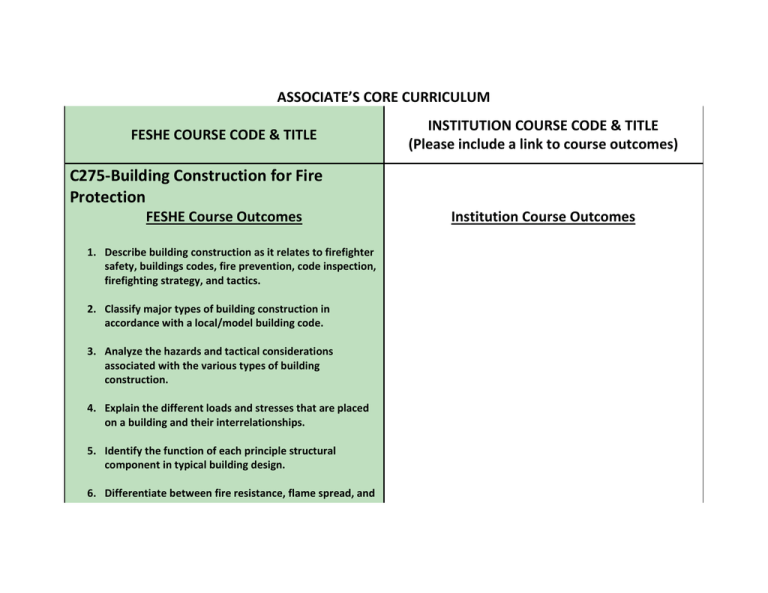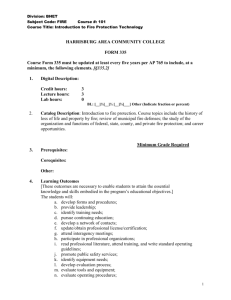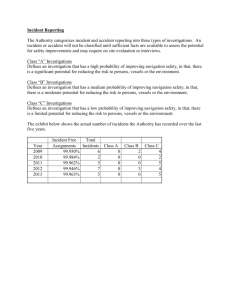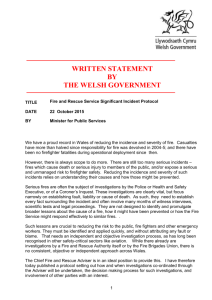Please include a link to course outcomes
advertisement

ASSOCIATE’S CORE CURRICULUM FESHE COURSE CODE & TITLE INSTITUTION COURSE CODE & TITLE (Please include a link to course outcomes) C275-Building Construction for Fire Protection FESHE Course Outcomes 1. Describe building construction as it relates to firefighter safety, buildings codes, fire prevention, code inspection, firefighting strategy, and tactics. 2. Classify major types of building construction in accordance with a local/model building code. 3. Analyze the hazards and tactical considerations associated with the various types of building construction. 4. Explain the different loads and stresses that are placed on a building and their interrelationships. 5. Identify the function of each principle structural component in typical building design. 6. Differentiate between fire resistance, flame spread, and Institution Course Outcomes describe the testing procedures used to establish ratings for each. 7. Classify occupancy designations of the building code. 8. Identify the indicators of potential structural failure as they relate to firefighter safety. 9. Identify the role of GIS as it relates to building construction. FESHE COURSE CODE & TITLE INSTITUTION COURSE CODE & TITLE (Please include a link to course outcomes) C276-Fire Behavior and Combustion FESHE Course Outcomes 1. Identify physical properties of the three states of matter. 2. Categorize the components of fire. 3. Explain the physical and chemical properties of fire. 4. Describe and apply the process of burning. 5. Define and use basic terms and concepts associated with the chemistry and dynamics of fire. 6. Discuss various materials and their relationship to fires as fuel. 7. Demonstrate knowledge of the characteristics of water as a fire suppression agent. Institution Course Outcomes 8. Articulate other suppression agents and strategies. 9. Compare other methods and techniques of fire extinguishments. FESHE COURSE CODE & TITLE INSTITUTION COURSE CODE & TITLE (Please include a link to course outcomes) C286- Fire Prevention FESHE Course Outcomes 1. Define the national fire problem and role of fire prevention. 2. Identify and describe fire prevention organizations and associations. 3. Define laws, rules, regulations, and codes and identify those relevant to fire prevention of the authority having jurisdiction. 4. Define the functions of a fire prevention bureau. 5. Describe inspection practices and procedures. 6. Identify and describe the standards for professional qualifications for Fire Marshal, Plans Examiner, Fire Inspector, Fire and Life Safety Educator, and Fire Investigator. 7. List opportunities in professional development for fire prevention personnel. 8. Describe the history and philosophy of fire prevention. Institution Course Outcomes FESHE COURSE CODE & TITLE INSTITUTION COURSE CODE & TITLE (Please include a link to course outcomes) C288- Fire Protection Systems FESHE Course Outcomes 1. Explain the benefits of fire protection systems in various types of structures. 2. Describe the basic elements of a public water supply system including sources, distribution networks, piping and hydrants. 3. Explain why water is a commonly used extinguishing agent. 4. Identify the different types and components of sprinkler, standpipe and foam systems. 5. Review residential and commercial sprinkler legislation. 6. Identify the different types of non-water based fire suppression systems. 7. Explain the basic components of a fire alarm system. 8. Identify the different types of detectors and explain how Institution Course Outcomes they detect fire. 9. Describe the hazards of smoke and list the four factors that can influence smoke movement in a building. 10. Discuss the appropriate application of fire protection systems. 11. Explain the operation and appropriate application for the different types of portable fire protection systems. FESHE COURSE CODE & TITLE INSTITUTION COURSE CODE & TITLE (Please include a link to course outcomes) C273- Principles of Emergency Services FESHE Course Outcomes 1. Illustrate and explain the history and culture of the fire service. 2. Analyze the basic components of fire as a chemical chain reaction, the major phases of fire, and examine the main factors that influence fire spread and fire behavior. 3. Differentiate between fire service training and education and explain the value of higher education to the professionalization of the fire service. 4. List and describe the major organizations that provide emergency response service and illustrate how they interrelate. 5. Identify fire protection and emergency-service careers in both the public and private sector. 6. Define the role of national, State and local support organizations in fire and emergency services. Institution Course Outcomes 7. Discuss and describe the scope, purpose, and organizational structure of fire and emergency services. 8. Describe the common types of fire and emergency service facilities, equipment, and apparatus. 9. Compare and contrast effective management concepts for various emergency situations. 10. Identify the primary responsibilities of fire prevention personnel including, code enforcement, public information, and public and private protection systems. 11. Recognize the components of career preparation and goal setting. 12. Describe the importance of wellness and fitness as it relates to emergency services. FESHE COURSE CODE & TITLE INSTITUTION COURSE CODE & TITLE (Please include a link to course outcomes) C281- Principles of Fire & Emergency Services Safety & Survival FESHE Course Outcomes 1. Define and describe the need for cultural and behavioral change within the emergency services relating to safety, incorporating leadership, supervision, accountability and personal responsibility. 2. Explain the need for enhancements of personal and organizational accountability for health and safety. 3. Define how the concepts of risk management affect strategic and tactical decision-making. 4. Describe and evaluate circumstances that might constitute an unsafe act. 5. Explain the concept of empowering all emergency services personnel to stop unsafe acts. 6. Validate the need for national training standards as they correlate to professional development inclusive of qualifications, certifications, and re-certifications. Institution Course Outcomes 7. Defend the need for annual medical evaluations and the establishment of physical fitness criteria for emergency services personnel throughout their careers. 8. Explain the vital role of local departments in national research and data collection systems. 9. Illustrate how technological advancements can produce higher levels of emergency services safety and survival. 10. Explain the importance of investigating all near-misses, injuries and fatalities. 11. Discuss how incorporating the lessons learned from investigations can support cultural change throughout the emergency services. 12. Describe how obtaining grants can support safety and survival initiatives. 13. Formulate an awareness of how adopting standardized policies for responding to emergency scenes can minimize near-misses, injuries and deaths. 14. Explain how the increase in violent incidents impacts safety for emergency services personnel when responding to emergency scenes. 15. Recognize the need for counseling and psychological support for emergency services personnel, their families, as well as, identify access to local resources and services. 16. Describe the importance of public education as a critical component of life safety programs. 17. Discuss the importance of fire sprinklers and code enforcement. 18. Explain the importance of safety in the design of apparatus and equipment. ASSOCIATE'S NON-CORE CURRICULUM FESHE COURSE CODE & TITLE INSTITUTION COURSE CODE & TITLE (Please include a link to course outcomes) C290- Advanced Concepts in Structural Fire Protection FESHE Course Outcomes 1. Analyze case studies from historical fires related to structural collapse and failure and emphasis on fire protection systems design. 2. Identify the principle structural components and evaluate the five types of building construction addressing special hazards and tactical considerations. 3. Develop and calculate approved fire resistance ratings employing established principles and models. 4. Describe the design objectives of fire resistance properties of assemblies including walls, floors, beams, columns, fire barriers and penetrations. 5. Describe the behavior of structural components and their mechanical properties (thermal strain, stress and fatigue) under fire conditions. Institution Course Outcomes 6. List and apply the “Ten Rules of Fire Endurance Rating”, according to ‘Harmathy’. 7. Evaluate occupancy designations and their respective fire resistance requirements according to state, local and regional building codes. 8. Describe the industry fire-resistive testing processes (e.g. ASTM E-119 test) for fire load, severity, and fire endurance according to NFPA and UL. 9. Evaluate the fire protection systems (e.g. spray on coatings, flame shields, encasements, barriers) for structural components in accordance with fire industry standards. 10. Identify the indicators of potential structural failure as they relate to firefighter safety and analyze the causes involved in the line of duty firefighter deaths related to structural firefighting. 11. Identify and analyze the causes involved in the line of duty firefighter deaths related to structural and wildland firefighting, training and research and the reduction of emergency risks and accidents. FESHE COURSE CODE & TITLE INSTITUTION COURSE CODE & TITLE (Please include a link to course outcomes) C294- Fire & Life Safety Education FESHE Course Outcomes 1. Differentiate between Public Education, Public Information and Public Relations/Marketing. 2. Demonstrate the need for establishing fire and life safety education as a value within the fire service culture. 3. Identify stakeholders; develop partnerships and coalitions to work on fire and life safety education activities. 4. Identify and use local, regional and national sources of data for fire and injury preventions programs. 5. Identify budget needs for program delivery and the process for requesting funds. 6. Select, design, implement, and evaluate fire and life safety education programs that specific community risk issues. Institution Course Outcomes 7. Develop an accountability system to measure program delivery. FESHE COURSE CODE & TITLE INSTITUTION COURSE CODE & TITLE (Please include a link to course outcomes) C283- Fire Investigation I FESHE Course Outcomes 1. Identify the responsibilities of a firefighter when responding to the scene of a fire, including scene security and evidence preservation. 2. Describe the implications of constitutional amendments as they apply to fire investigations. 3. Identify key case law decisions that have affected fire investigations. 4. Define the common terms used in fire investigations. 5. Explain the basic elements of fire dynamics and how they affect cause determination. 6. Compare the types of building construction on fire progression. 7. Describe how fire progression is affected by fire protection systems and building design. Institution Course Outcomes 8. Discuss the basic principles of electricity as an ignition source. 9. Recognize potential health and safety hazards. 10. Describe the process of conducting investigations using the scientific method. 11. Identify cause and origin and differentiate between accidental and incendiary. 12. Explain the procedures used for investigating vehicle fires. 13. Identify the characteristics of an incendiary fire and common motives of the fire setter. FESHE COURSE CODE & TITLE INSTITUTION COURSE CODE & TITLE (Please include a link to course outcomes) C284- Fire Investigation II FESHE Course Outcomes 1. Explain the rule of law as it pertains to arrest, search and seizure. 2. Interpret a fire scene. 3. Describe the chemistry of combustion. 4. Explain the nature and behavior of fire. 5. Identify the combustion properties of liquid, gaseous, and solid fuels. 6. Analyze electrical causes of fires. 7. List the procedures for fingerprinting and evidence collection/preservation. 8. Evaluate the use of incendiary devices, explosives, and bombs. 9. List the procedures for fire scene documentation. Institution Course Outcomes 10. Analyze fire-related deaths and injuries. 11. Discuss interviewing techniques. 12. Explain the role of the fire investigator in courtroom demeanor and testifying. 13. List the sources and technology available for fire investigations. 14. Describe procedures for conducting background investigations. FESHE COURSE CODE & TITLE INSTITUTION COURSE CODE & TITLE (Please include a link to course outcomes) C292- Fire Plans Review FESHE Course Outcomes 1. Describe at least three reasons for performing plan checks, the objectives of a proposed plans review program, the impact of such a program, and how the program will enhance current fire prevention programs. 2. Develop a graphic illustration of a model plans review system, identifying at least four components involved in the system including the use of plans review checklists. 3. List three methods to monitor and evaluate the effectiveness of code requirements according to applicable standards. 4. Determine fire department access, verify appropriate water supply, and review general building parameters. 5. Determine occupancy classification, construction type; calculate occupant load and height and area of a building. 6. Determine the appropriateness of the three Institution Course Outcomes components of building’s egress system (exit access, exit, and exit discharge), verify building compartmentation and the proper enclosure of vertical openings. 7. Identify special hazards, verify interior finish and establish the proper location for pre-engineered fire extinguishing systems. 8. Verify the compliance of a heating, ventilating, and air conditioning (HVAC) system, review sources requiring venting and combustion air, verify the proper location of fire dampers, and evaluate a stairwell pressurization system. 9. Verify the proper illumination for exit access, the arrangement of exit lighting, and perform a life safety evaluation of the egress arrangement of a building. 10. Verify the design of a fire alarm and detection system, and an offsite supervisory system for compliance with applicable standards. FESHE COURSE CODE & TITLE INSTITUTION COURSE CODE & TITLE (Please include a link to course outcomes) C277- Fire Protection Hydraulics & Water Supply FESHE Course Outcomes 1. Apply the application of mathematics and physics to the movement of water in fire suppression activities. 2. Identify the design principles of fire service pumping apparatus. 3. Analyze community fire flow demand criteria. 4. Demonstrate, through problem solving, a thorough understanding of the principles of forces that affect water, both at rest and in motion. 5. List and describe the various types of water distribution systems. 6. Discuss the various types of fire pumps. Institution Course Outcomes FESHE COURSE CODE & TITLE INSTITUTION COURSE CODE & TITLE (Please include a link to course outcomes) C282- Hazardous Materials Chemistry FESHE Course Outcomes 1. Identify and describe the common elements of the Periodic Table. 2. Distinguish between elements, compounds, and mixtures. 3. Explain the difference between ionic and covalent bonding. 4. Define the basic chemistry involved with common hydrocarbon derivatives. 5. Describe the basic chemical and physical properties of gases, liquids, and solids. 6. Discuss the nine U.S. Department of Transportation hazard classes and their respective divisions. 7. Demonstrate the utilization of guidebooks, MSDS, and other reference materials to determine an initial course of action. Institution Course Outcomes FESHE COURSE CODE & TITLE INSTITUTION COURSE CODE & TITLE (Please include a link to course outcomes) C291- Human Behavior in Fire FESHE Course Outcomes 1. Categorize the types of behavior that people exhibit in fire situations as positive or negative as they effect emergency evacuation. 2. Outline three fire scenarios and describe the possible physiological impact each may have on building occupants and responding firefighters. 3. Identify four psychological traits of building occupants which may effect their identification of and response to a fire. 4. Perform algebraic estimates of occupant evacuation times from buildings. 5. Identify the two primary modeling techniques used to estimate evacuation times in large buildings and transportation facilities. 6. Identify at least four occupancies where human behavior and response characteristics are unique to Institution Course Outcomes occupancies and where there is a high potential life loss. 7. Write a summary of the human factors effecting high life loss in a major fire incident. 8. Identify five occupancies in your town/city/jurisdiction where human factors and building design may be factors in emergency evacuation. For one of these occupancies, list fire department procedures which should be implemented to deal with a major incident. 9. Develop a fire scenario and provide an estimate of the effective time of operation for the first responding firefighters. 10. Understand aspects of human behavior in mass casualties. 11. Identify and analyze the causes involved in the line of duty firefighter deaths related to structural and wildland firefighting, training and research and the reduction of emergency risks and accidents. FESHE COURSE CODE & TITLE INSTITUTION COURSE CODE & TITLE (Please include a link to course outcomes) C272- Principles of Fire & Emergency Service Administration FESHE Course Outcomes 1. Acknowledge career development opportunities and strategies for success. 2. Recognize the need for effective communication skills both written and verbal. 3. Identify and explain the concepts of span and control, effective delegation, and division of labor. 4. Select and implement the appropriate disciplinary action based upon an employee’s conduct. 5. Explain the history of management and supervision methods and procedures. 6. Discuss the various levels of leadership, roles, and responsibilities within the organization. 7. Describe the traits of effective versus ineffective management styles. Institution Course Outcomes 8. Identify the importance of ethics as it relates to fire and emergency services. 9. Identify the roles of the National Incident Management System (NIMS) and Incident Management System (ICS). FESHE COURSE CODE & TITLE INSTITUTION COURSE CODE & TITLE (Please include a link to course outcomes) C270- Legal Aspects of the Emergency Services FESHE Course Outcomes 1. Define the different types of laws. 2. Discuss Federal, State, and local laws and liabilities applicable to emergency services. 3. Explain the purpose of national codes and standards. 4. Discuss applicable court decisions that have influenced emergency services. 5. Recognize the legal issues and concerns affecting emergency services. Institution Course Outcomes FESHE COURSE CODE & TITLE INSTITUTION COURSE CODE & TITLE (Please include a link to course outcomes) C278- Occupational Health & Safety FESHE Course Outcomes 1. Describe the history of occupational health and safety. 2. Identify occupational health and safety programs for industry and emergency services today. 3. Compare the difference between standards and regulations. 4. List and describe the components of risk identification, risk evaluation, and incident management. 5. Describe the relevance for safety in the work place including the importance of PPE. 6. Apply the knowledge of an effective safety plan to preincident planning, response, and training activities. 7. Explain the components of an accountability system in emergency service operations. 8. Discuss the need for and the process used for postincident analysis. Institution Course Outcomes 9. Describe the components and value of critical incident management programs. 10. Describe the responsibilities of individual responders, supervisors, safety officers, and incident commanders, safety program managers, safety committees and fire department managers as they relate to health and safety programs. 11. Describe the components of a wellness/fitness plan. 12. Identify and analyze the major causes involved in lineof-duty firefighter deaths related to health, wellness, fitness and vehicle operations. FESHE COURSE CODE & TITLE INSTITUTION COURSE CODE & TITLE (Please include a link to course outcomes) C289- Performance-Based Design Fire Protection FESHE Course Outcomes 1. Given examples of a performance-based design and a prescriptive-base design, describe the differences. 2. Given a fire spread scenario, explain the progression of the fire from start to extinguishment. 3. Given specific life safety criteria and non-life safety criteria requirements, determine whether a performance-based building design submitted for approval would meet the criteria of the local jurisdiction. 4. Describe the capabilities and limitations of the fire model(s) on which the design was based. 5. Evaluate performance-base design reports and verify whether documentation submitted is adequate. 6. Comprehend the types of building commissioning and acceptance testing associated with performance-based Institution Course Outcomes design buildings. 7. Identify and analyze field changes, building limitations, allowable alterations and renovations. 8. Describe the dynamics of fire. FESHE COURSE CODE & TITLE INSTITUTION COURSE CODE & TITLE (Please include a link to course outcomes) C293- Principles of Code Enforcement FESHE Course Outcomes 1. Explain the code enforcement system and the fire inspector’s role in that system. 2. Describe the codes and standards development and adoption processes. 3. Describe the difference between prescriptive and performance based codes. 4. Describe the legal authority and limitations relevant to fire code inspections. 5. Describe the importance of thorough documentation. 6. Recognize ethical practices for the code enforcement officer. 7. Explain the application, and interrelationship of codes, standards, recommended practices and guides. Institution Course Outcomes 8. Describe the differences in how codes apply to new and existing structure. 9. Identify appropriate codes and their relationship to other requirements for the built environment. 10. Describe the political, business, and other interests that influence the code enforcement process. 11. Identify the professional development process for code enforcement practitioners. FESHE COURSE CODE & TITLE INSTITUTION COURSE CODE & TITLE (Please include a link to course outcomes) C279- Strategy & Tactics FESHE Course Outcomes 1. Discuss fire behavior as it relates to strategies and tactics. 2. Explain the main components of pre-fire planning and identify steps needed for a pre-fire plan review. 3. Identify the basics of building construction and how they interrelate to pre-fire planning and strategy and tactics. 4. Describe the steps taken during size-up. 5. Examine the significance of fire ground communications. 6. Identify the roles of the National Incident Management System (NIMS) and Incident Management System (ICS) as it relates to strategy and tactics. 7. Demonstrate the various roles and responsibilities in ICS/NIMS. Institution Course Outcomes



